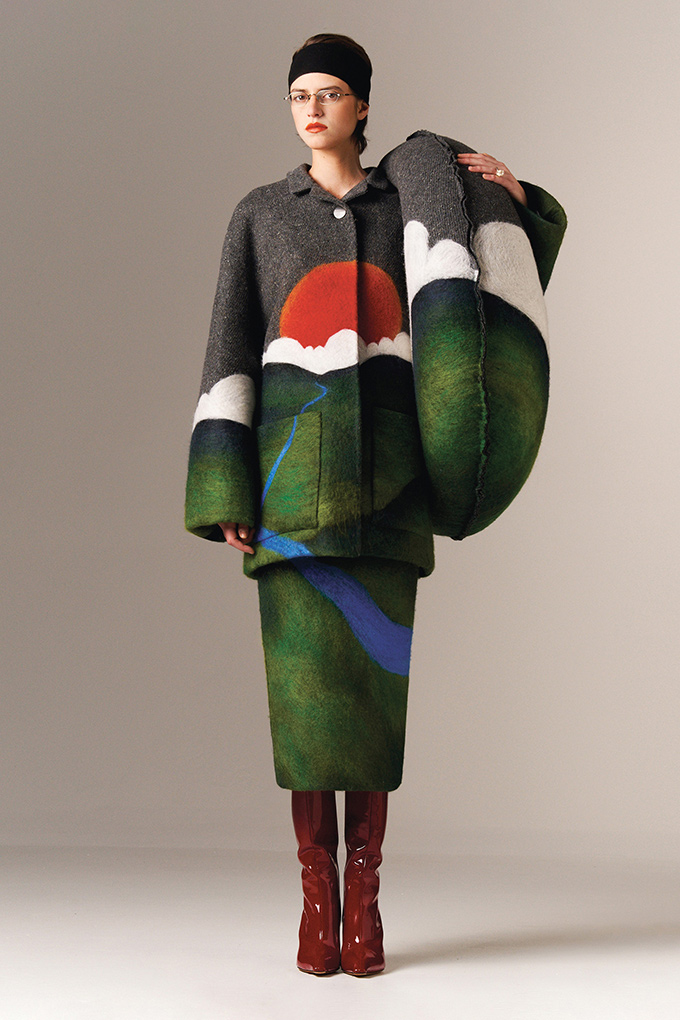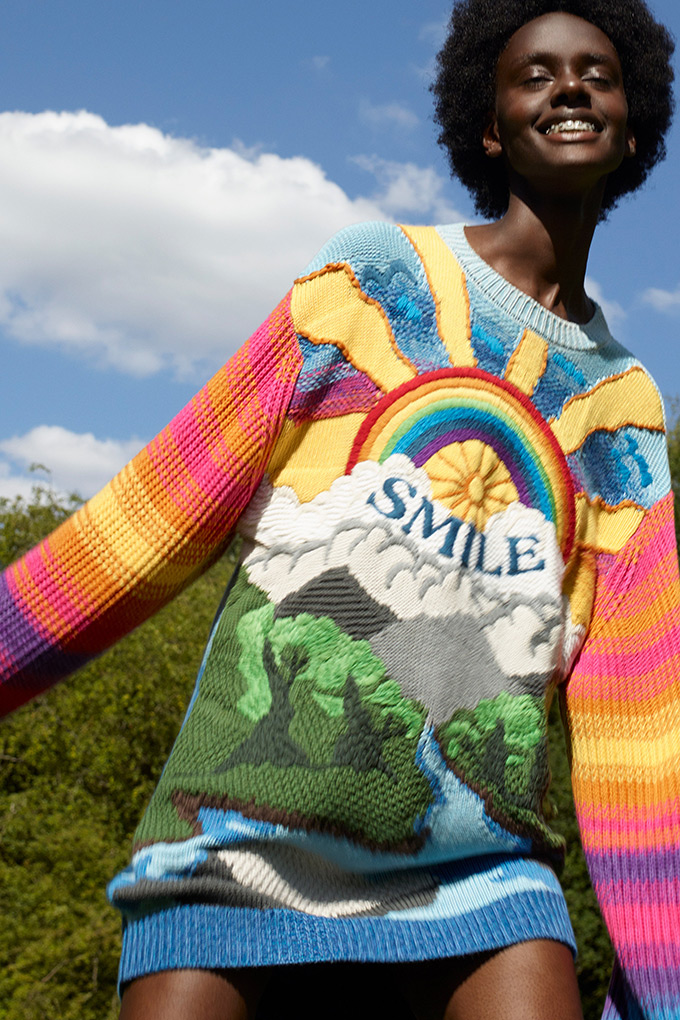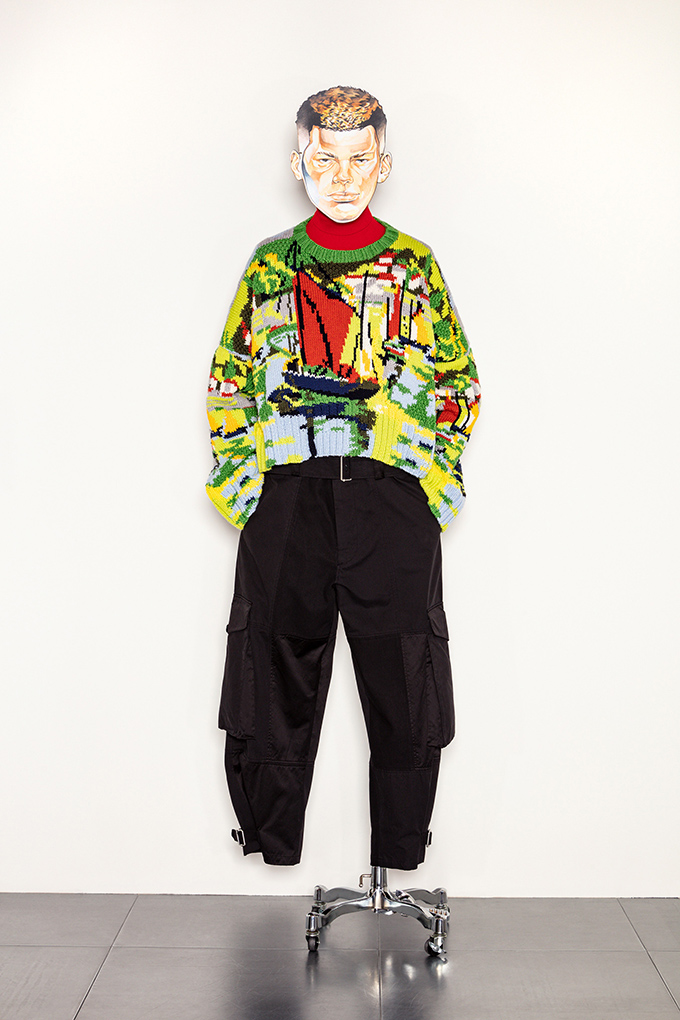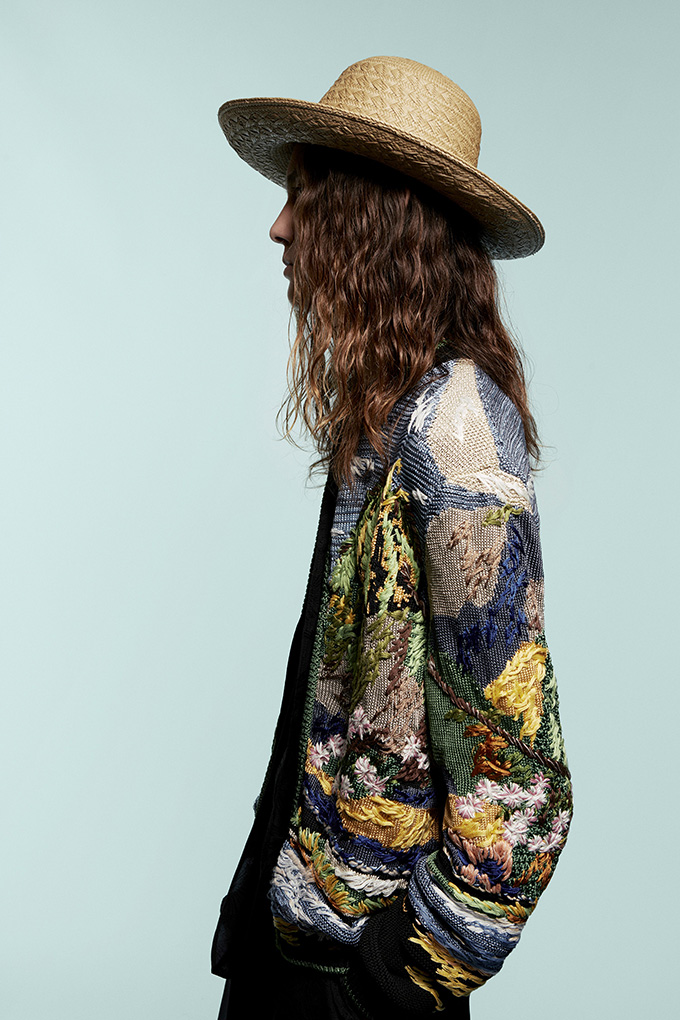Picture the scene. A peaceful river runs through green plains and hills. On the horizon, a plump orange sun rises behind fluffy clouds. This isn’t a painting, though. It’s not a photograph or pastoral cinematic moment either. It’s a two-piece felted suit, worn with patent boots and an austere black headband.

The opening look of Central Saint Martins’ graduate Conner Ives’ AW21 Americana-influenced offerings (which also forms his CSM womenswear BA graduate collection) tells an intriguing story. Inspired by the designer unearthing his mother’s collection of American folk art stored in her attic—“It was like discovering a lost city,” Ives tells Vogue—this creation is part garment, part walking canvas. Both the hand-felted suit and an accompanying bag were created in collaboration with textiles artist Mati Hays. The effect is vivid, conjuring a yearning for a landscape at once strange and archetypally familiar.
Clothes as a window to the great outdoors

Ives isn’t the only designer who’s been dabbling in a bit of landscaping. Rural scenery has become an increasingly popular motif of late, with designs ranging from Jacquemus’s earthy vistas and Ashish’s psychedelic mountains and mushrooms to House of Sunny’s verdant sweaters. Moschino’s AW21 collection also took a bucolic turn in the form of prints featuring bright-blue skies and daisy-strewn meadows full of cows. For Moschino creative director Jeremy Scott, the cloud print is an obvious place to alight: it’s a Moschino classic. However, this particular set of designs also paid homage to 1930s MGM designer Gilbert Adrian, the man behind the costumes for The Wizard of Oz (1939).
Scott’s theatrical video presentation, featuring revolving scenery and sections devoted to business, countryside leisure, eveningwear and more, took direct inspiration from 1939 film The Women, which includes a five-minute technicolour fashion show costumed by Adrian. Several years later, the designer also produced a silk crepe ‘patio’ dress (so called because it was suitable for outdoor entertaining) inspired by his home in the San Fernando Valley, Los Angeles. With little padded shoulders and a full, sweeping skirt, Adrian’s frock depicts lambs merrily bounding around a lush field.



Recently, a plethora of mountains, fields and seascapes have also found their way on to all manner of knitwear, cardigans and sweater vests. Lirika Matoshi, who created the infamous glittering strawberry dress that dominated summer 2020, is also producing knitwear studded with clouds. Brands including Saint Laurent, Stella McCartney and JW Anderson have debuted intarsia knits starring riverbanks and greenery. Recently, Gabriela Hearst’s resort 2022 collection included several sweaters with landscape images of famous north and south American landmarks including Yellowstone National Park and Peru’s Machu Picchu.
At the more luxe end of the scale, such designs do two things simultaneously. They draw attention to the intricacy of their construction, especially where the knits have been made by hand, while also suggesting a deliberate note of cheesiness. Some of these garments resemble children’s drawings—a house, a hill, a perfectly round sun—or the kinds of scenes you get on the sweaters sold at tourist destinations. Others evoke the current fervour for homespun 1980s knits (see also the renewed love of Diana, Princess of Wales’s sweaters this past year, thanks in part to The Crown, season 4), revelling in their own kitsch.



Of course, placing a landscape on a garment is nothing new. In 1611, Johann Georg I of Saxony was given an extraordinary ‘landscape cloak’ by his mother as a Christmas gift. This cape is decorated with detailed views of Dresden and the River Elbe sewn on to a background of blue velvet. This may be at the more showy end of the scale, but ornamental stitching has a wide and varied history. Over many hundreds of years, waves, clouds, mountains, rainbows and forests have all been painstakingly embroidered on to clothes and accessories ranging from sleeping caps to reticules (a small bag or purse). Kimono, too, are particularly rich in details drawn from the natural world: with many textiles designs featuring stunning printed or embroidered scenery evoking different seasons, locations and stories.
A sense of escape
It’s unsurprising to see so many designers turning once more towards the expansive embrace of the countryside. The past 16 months have included disorienting periods of feeling trapped, leaving people fantasising about travel, wilderness and the lure of the unfamiliar. Think of this as the more literal endpoint of cottagecore. Why dress like you’re hoping to waft around a meadow of wildflowers when you could just wear the meadow instead? It’s a sliver of escapism in textile form, triggering the same sense of calm and pleasure we might feel when looking at a van Gogh or a David Hockney.

Given this escapist element, it’s notable how many of these designs are based on more painterly or cartoonish depictions of the great outdoors. The early 2010s featured a lot of landscapes too, but these tended to be more photo-real, kaleidoscopic renditions or twee patterns best suited to tea-dresses. These scenes, by comparison, are punchy. They might draw from nature, but the colours are brighter and the edges smoother. At times, they resemble the bright graphics of a video game or an illustrated postcard you might send saying, ‘Wish you were here.’ Perhaps they are less landscapes than they are dreamscapes: each garment blending the real and the unreal, carrying with it the tantalising suggestion of somewhere else entirely.





